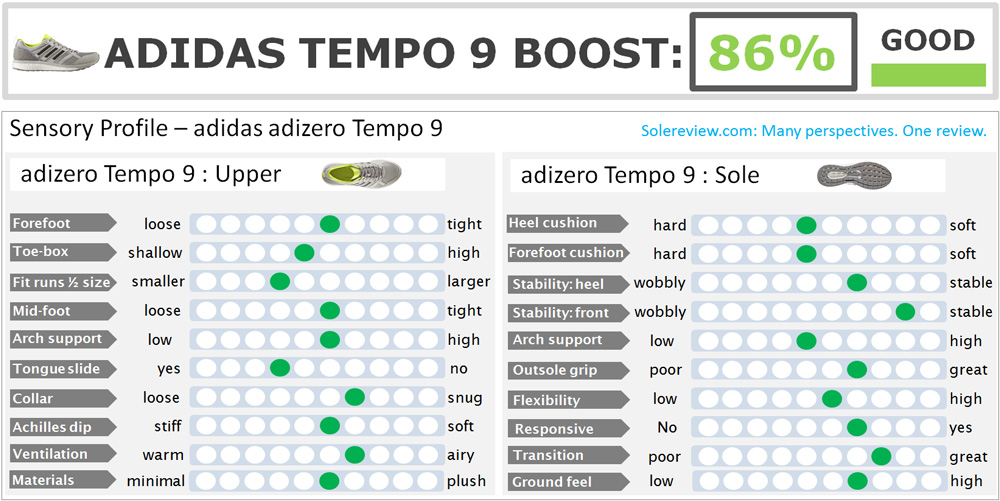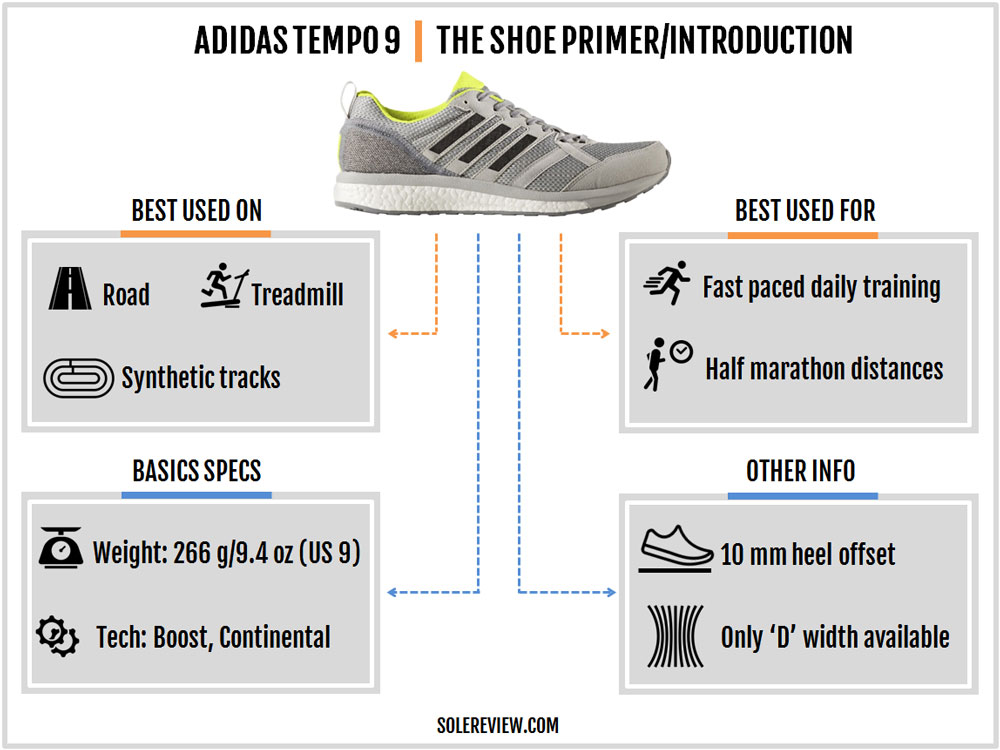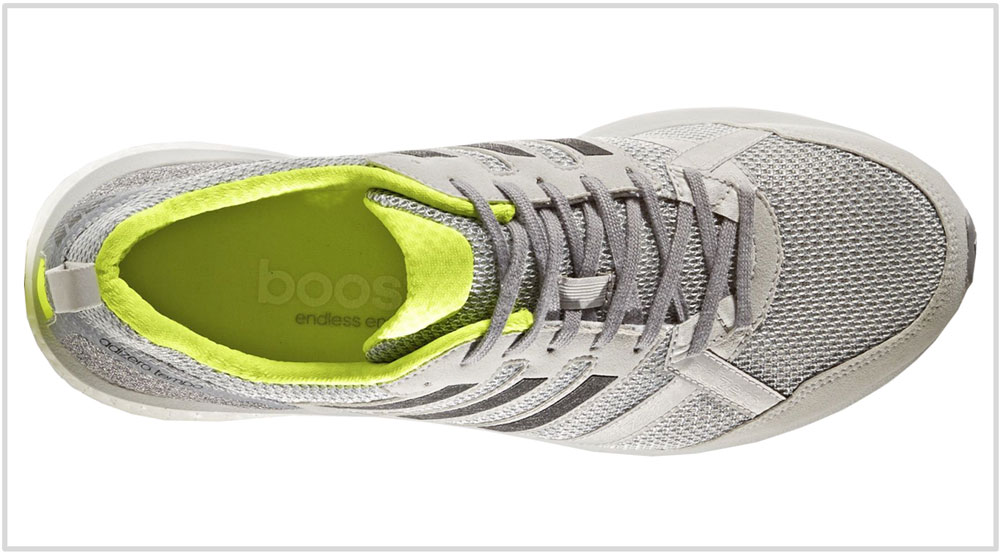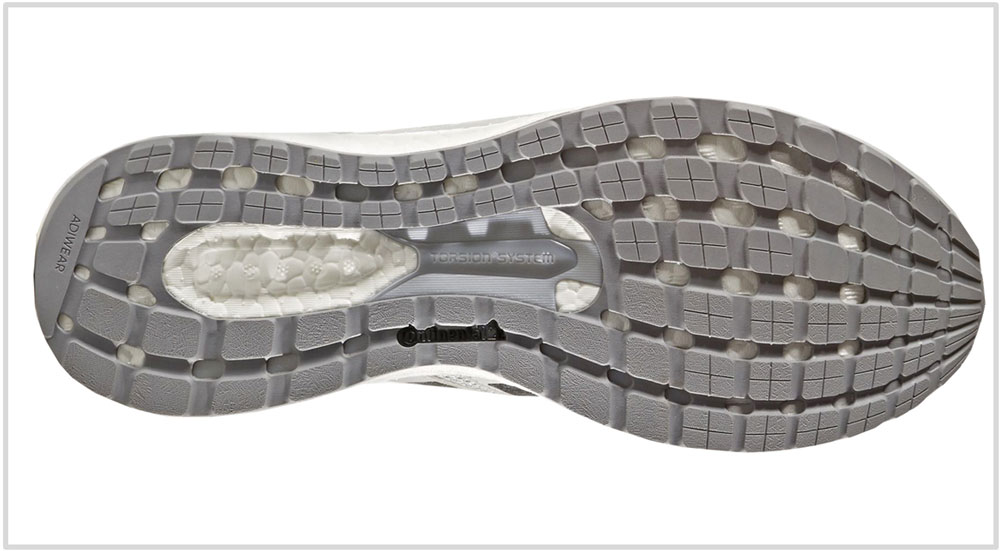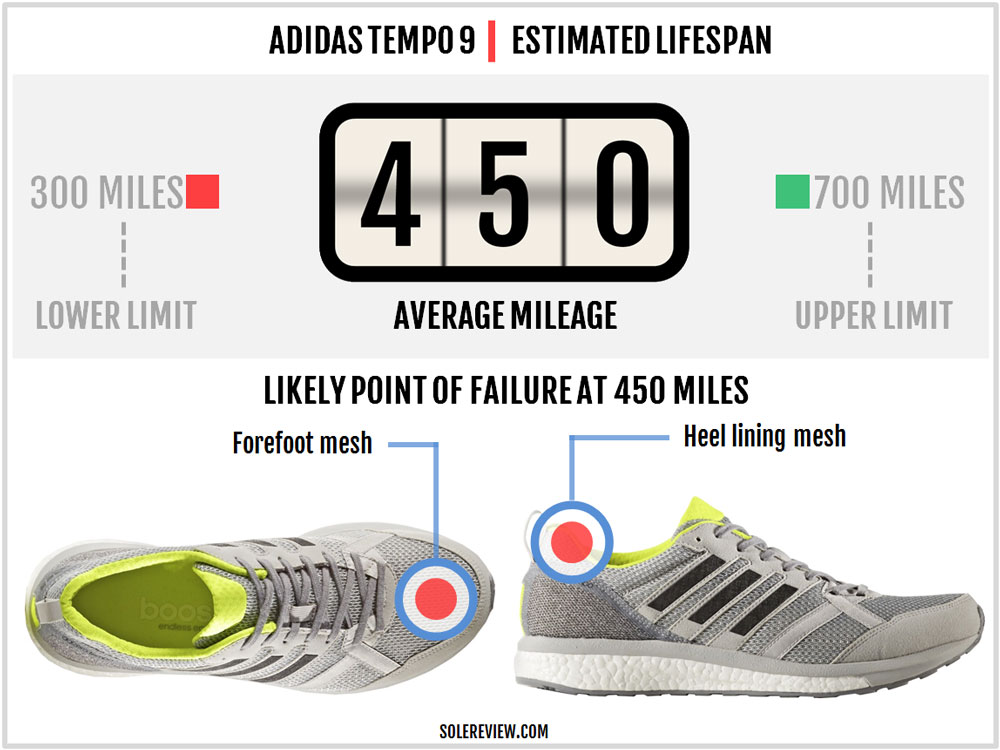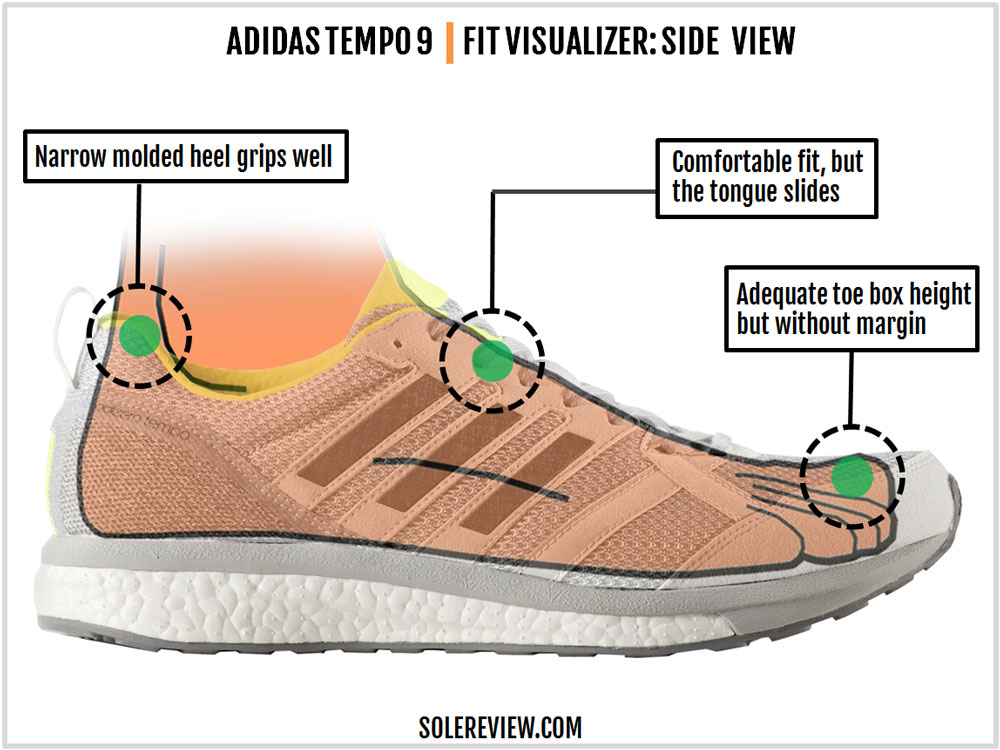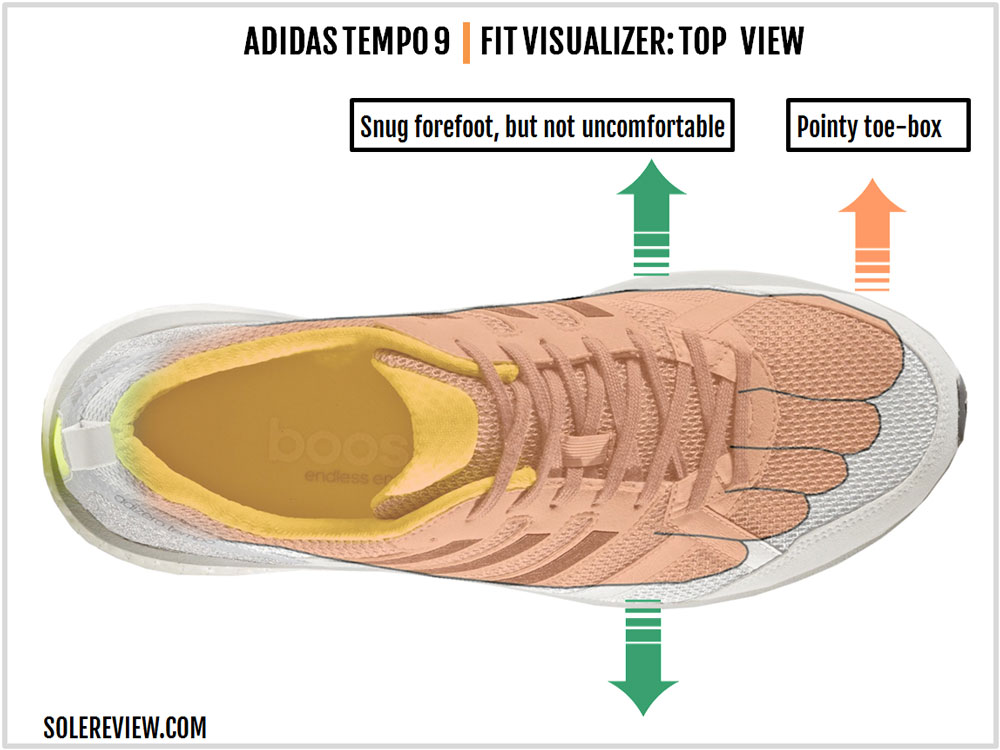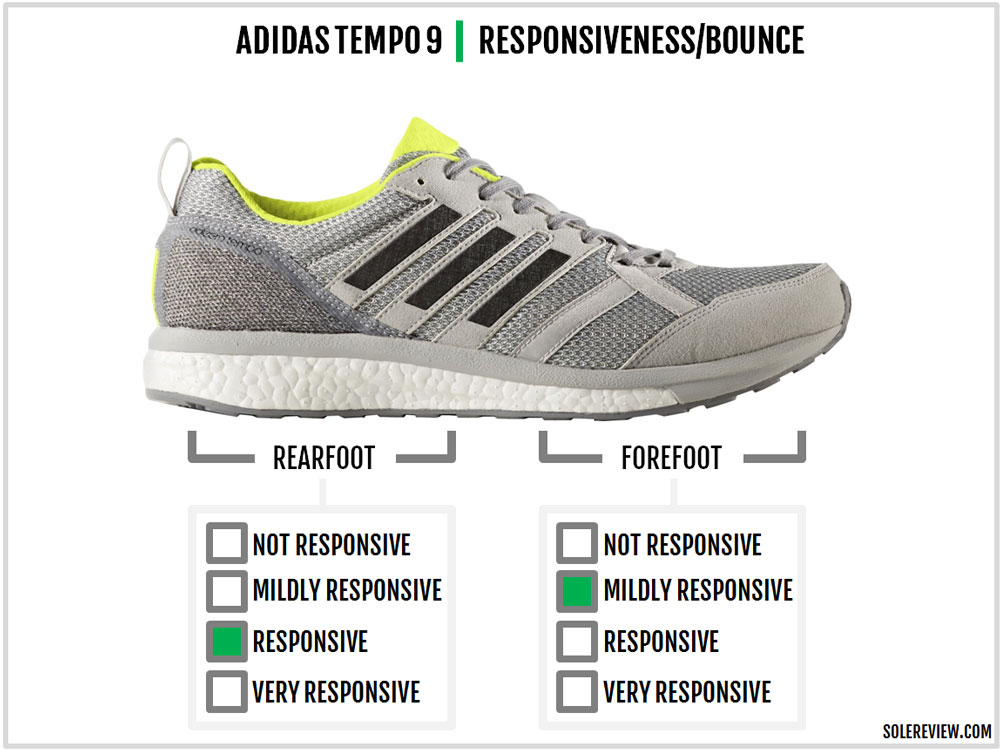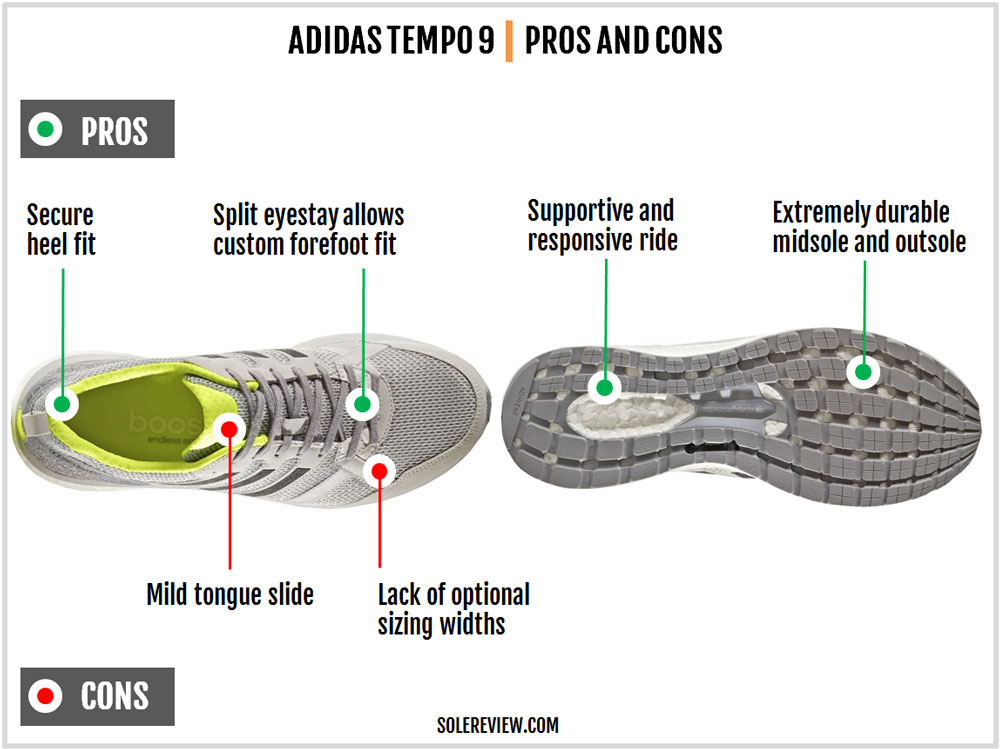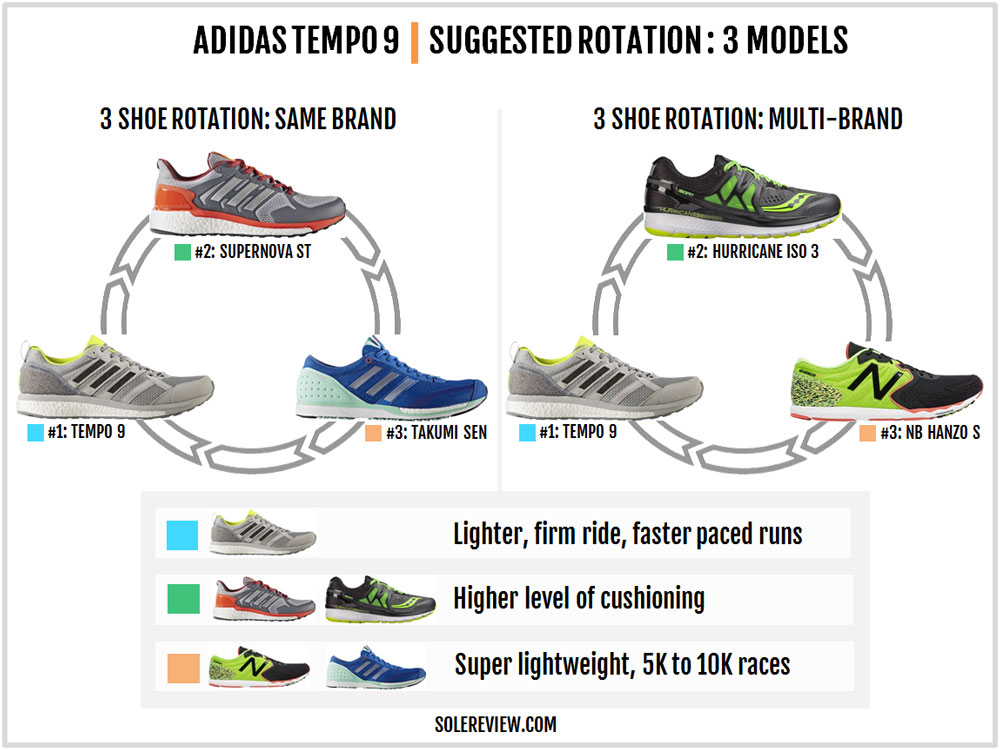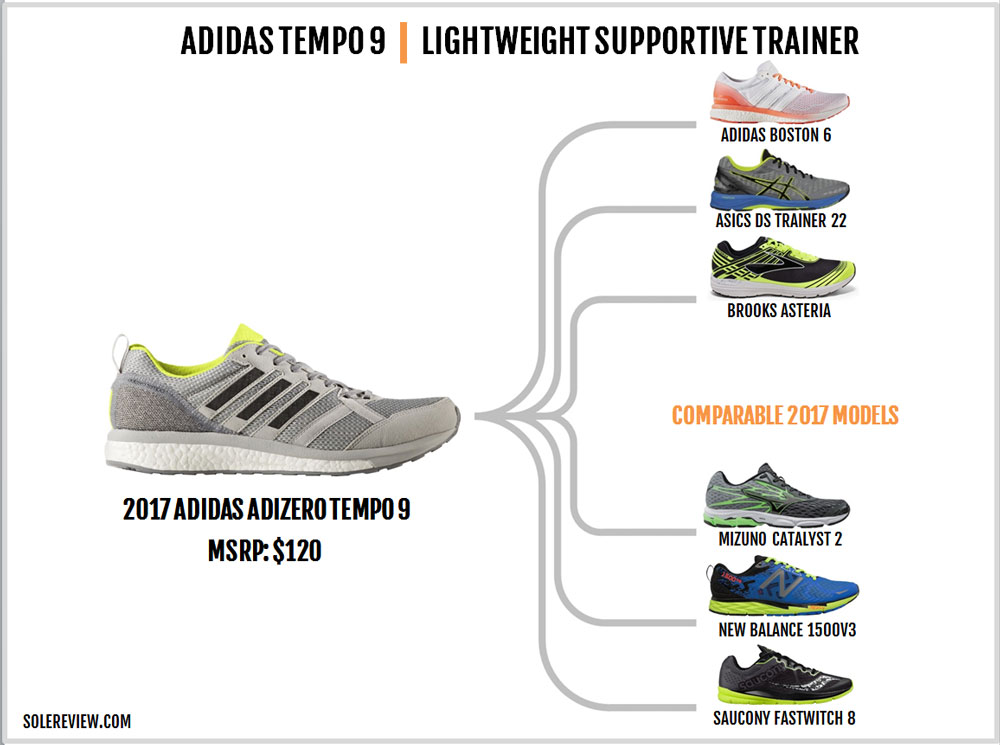INTRODUCTION
The adizero Tempo 9 is adidas’s fast training running shoe with a mild support element. One way to look at it would be to do so as a lighter and slimmer version of the Supernova ST. The latter is a cushioned trainer suitable for longer distances, while the Tempo 9 is a much lighter shoe suited for races and training runs of similar paces.
The Boston 6 has to be mentioned in the same breath as the Tempo, for the two shoes are (now) remarkably similar. Considering that the Tempo 9 does not use a firmer medial-post, it won’t be wrong to treat the shoe as a slightly more supportive version of the Boston.
This year’s Tempo 9 features a brand new set of midsole and outsole. The end product is a marginally softer ride experience, the result of less EVA on the midsole and an outsole design with bigger windows. And mind you, the Tempo 9 no longer uses the word ‘Stableframe.’ Taking its place is adidas’s new ‘Energized stability’ film over the inner midsole.
The Tempo also receives a new set of clothes; the upper switches to a subdued aesthetic scheme along with a couple of elements which influence the quality of fit.
DESIGN AND MATERIALS
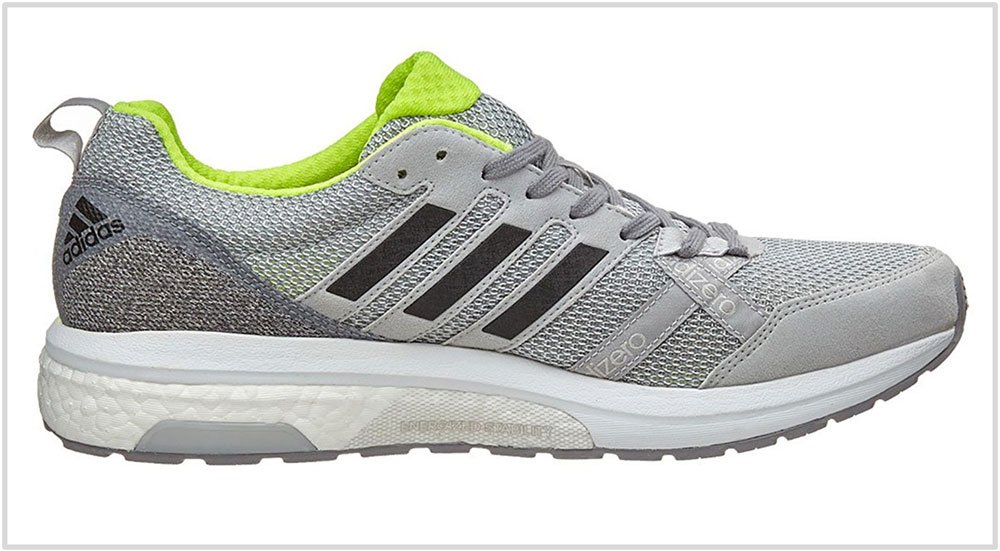
There’s nothing groundbreaking about the Tempo 9’s upper, just a tried-and-tested combination of materials and placement. Synthetic suede is used liberally over the upper which not only lends a subtle look but also makes the shoe supple.
The toe-bumper is a largish piece of suede, and the lacing panel and the three-stripes logo are made of the same material. There’s something about suede which gives any shoe an understated look, and adidas has put it to good use here.
The laces are flat and have a cottony texture which keeps them tied together.
The inner sleeve which formed a part of the Tempo 7 and 8’s interiors is gone. It is replaced by a thin and softer tongue with a traditional lace loop. And while we have always appreciated an inner sleeve in the past, the Tempo is better off without it. The past two adizero Tempos had sleeves, but the standard of assembly was sub-par.
By switching to a simpler construction minus an inner sleeve, the Tempo 9 ends up a much better finished model. There’s also visual clean-up in the form of the redesigned heel; gone are the glossy layers of synthetic seen on the V8.
Instead, a thin transparent laminate is applied over the external heel. Inside, there’s a stiff counter like before. The collar lining and foam fill levels stay unchanged from the V8. The heel upper gets a nylon pull tab, which is a new design addition.
The forefoot and the midfoot mesh is also now a single kind of spacer mesh, which is a cleaner approach than the multiple mesh types used on the V8. All said and done, the most important update on the Tempo 9’s upper is the split eyestay.
Instead of having a single midfoot suede panel – as it was on the Tempo 7 and 8, the Tempo 9’s first two lacing rows are mounted on a separate strip of synthetic.
This new arrangement allows those rows to operate independently; this can affect the fit quality, depending on how you lace the Tempo 9.
Like for like, though, the Tempo 9 has less layering on the forefoot side. There are a couple of thin straps in a criss-cross formation which opens up the forefoot more than the Tempo 9’s synthetic covered design did. adidas calls this design ‘Japanese Origami’ inspired, presumably based on the art of Japanese paper folding.
On a side note, 2016 was the year of mid-season model refreshes. The Supernova Glide changed its outsole half way through the year, and the Tempo refreshed its upper mesh as well.
As a result, there were a couple of Tempo variants available to buy, depending on which retailer’s website you were on. If that wasn’t confusing enough, there was even a separate women’s version.
For now, it seems that the Tempo 9 will be consistent for 2017.
If you’re familiar with the adidas’s Supernova, Boston, and Tempo series of running shoes, you’ll feel right at home with the Tempo 9’s midsole.
A familiar combination of the firmer EVA rim on top and a full-length Boost midsole is deployed on the Tempo. While this design is similar to the what’s on the adios 3 and the Boston, the Tempo 9 does a few things differently.
When compared to the Boston, the EVA component is slightly larger, while the Boost foam is present in a larger volume than the race-day adios 3. So in terms of cushioning, it won’t be wrong to say that the Tempo 9 sits midway between the adios and the Boston. The Tempo also has a couple of other features befitting its ‘support’ categorization.
The last two Tempo versions had a ‘Stableframe’ midsole with slightly more support and material on the inner side and around the heel. On the inner midsole, the EVA portion extended till the midfoot as a means of additional support. The EVA near around the Tempo 7 and 8’s heel was also raised higher and served as a cupping base of sorts.
This year, the Tempo 9 gets a midsole with the EVA portion trimmed down – both near the forefoot and the heel. In their place are a couple of new features.
The inner midsole has a thin film over the Boost which adidas calls ‘Energized Stability.’ This is keeping in line with the changes on the Supernova ST (previously called the Sequence) which also switched from a larger Stableframe midsole to a combination of a slimmer midsole and a thin laminate.
As a matter of fact, adidas no longer mentions ‘Stableframe’ in the Tempo 9’s description. adidas claims that the Boost midsole is dual-density, but it is technically not so. The thin film over the midsole does add some firmness, but then, that’s a separate component over what is unarguably a single-density Boost midsole.
Also, there’s a larger ‘Torsion’ plastic component between the midsole and the outsole, one which also extends to the inner sidewall like the adizero adios. Parts of the plastic also extends under the forefoot for added stiffness.
The outsole is a combination of Continental rubber and adiwear used liberally over the forefoot and rearfoot. There are minor changes like larger rubber lugs and increased windows exposing the Boost foam beneath.
The higher number of windows makes the ride slightly softer, as was the case on the Boston 6. There are a few things carried over from the previous design, such as the beveled/angled heel for gradual heel strikes and transitions. Inside, there’s a chunky EVA foam insole which adds extra cushioning over the midsole.
With all the changes, the Tempo 9 gains 11 grams/0.4 ounces over the outgoing model.
Ever since the pairing of the Boost foam and Continental rubber outsole began, the general trend has been that of the sole unit outliving the upper. The Boost foam and adidas’s rubber compound are highly resistant to wear and tear, so it is likely that parts of the upper will fail first.
For example, the shallow toe-box mesh or the heel lining areas will undergo expected wear and tear. This is a natural occurrence once the shoe crosses a mileage threshold of a few hundred miles.
UPPER FIT AND FEEL
The Tempo’s upper fit is closely modeled on race-day shoes, which means that an overall snug fit including a relatively shallow toe-box is part of the territory. While the toe-box doesn’t pin down the big toe, there’s isn’t any margin left over either.
The midfoot gets a conventional fit and feel, thanks to the thin and sleeve-free tongue. Unlike the Tempo 7 and 8, there’s no inner sleeve, so the fit goes slightly relaxed. The downside is that you experience tongue slide which is associated with a sleeve-free design.
In the back, the narrow molding of the internal counter keeps the foot locked in, despite the minimal amount of foam padding.
The Tempo 9 gets more forefoot room than the Tempo 7 and 8. There’s a lot more open mesh area compared to the previous year models which had synthetic over both sides. This change, when combined with the lack of an inner sleeve, makes the Tempo 9 more breathable too.
But there’s a catch. As the first two lacing rows are mounted on a separate panel, cinching them tight will lead to a noticeable increase in narrowness. This isn’t a bad thing, considering that a snug forefoot fit works great for fast track runs.
All the same, if you’re using the Tempo 9 for longer runs like a half marathon, you should be mindful not to over-tighten the lacing in the front. Also, we recommend buying a half-size larger – unless you’re limiting the Tempo’s use only to track runs.
The first two rows also add some extra synthetic over the toe-box which was previously missing. This means that you’ll sense the additional material over your foot when flexing. For this sensation to disappear completely, you’ll need to account for a break-in period of a week or so.
RIDE QUALITY AND BEHAVIOR
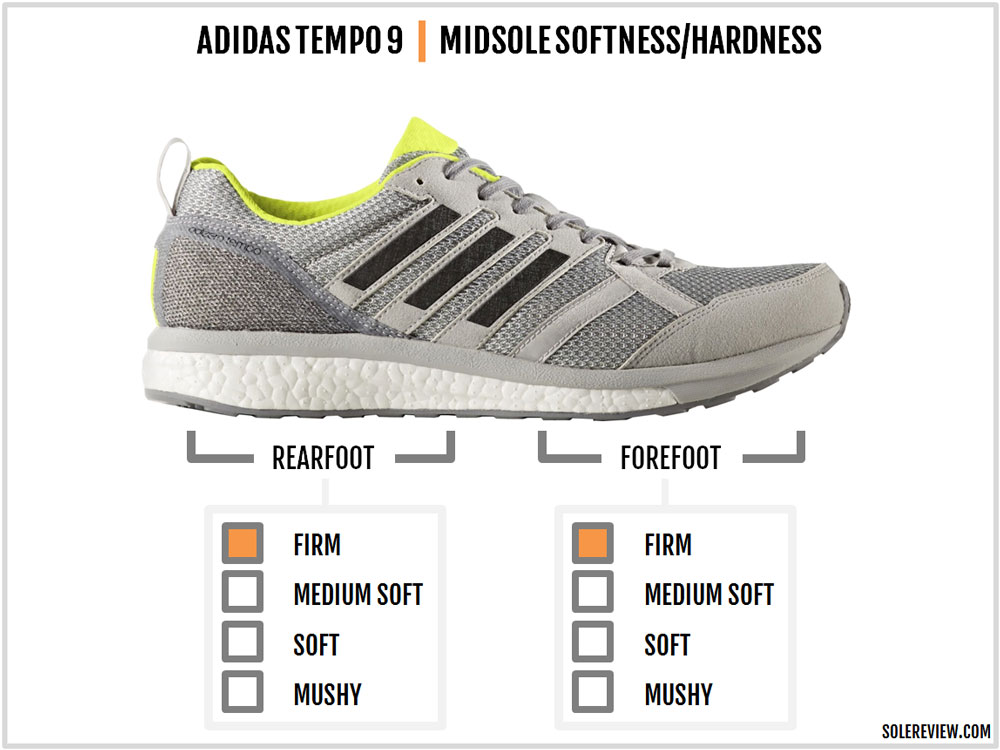
The Tempo 9 has a firm ride. The only layer of softness you get is from the molded insole sitting atop the midsole; the rest is firm cushioning. Unlike the more cushioned Boost models like the Supernova and Energy, the amount of Boost available on the Tempo is just enough to make the ride cushioned but not soft.
The Tempo 9’s EVA midsole also covers the Boost completely over the heel as opposed to being just a rim on the Boston, so that also contributes to the firm ride character.
There’s enough cushioning to run half marathons, though if you’re running anything longer, we recommend a second shoe – see our rotation section later in this review.
Soft the Tempo 9 may not be, but responsive it certainly is. The Boost has a nice springback quality about it, and you feel it with each footstrike. The transitions are also efficient due to uniformity in the material used – be it the Boost or outsole rubber, everything is used in a full-length format.
For all practical purposes, the Tempo 9 is a neutral running shoe. This statement has greater relevance for the Tempo 9 than the 7 and 8 which had a larger Stableframe. With a bulk of the EVA gone and substituted with Boost foam, the midsole exhibits a ride quality which feels uncannily similar to the Boston and adios.
As mentioned before, the larger windows on the outsole design make the Tempo 9 a bit softer than the 7 and 8. Coincidentally, this is an update similar to what we experienced on the Boston 6 versus the 5.
PROS AND CONS
The Tempo 9 doesn’t have many faults. The ride is cushioned and responsive, the transitions feel quick, and the model is lightweight too. The midsole and outsole are very durable, and the upper is reasonably breathable. The split eyestay allows a custom level of fit to be achieved through the front rows.
If we had to nitpick, we’d point out the Tempo 9’s unavailability of optional sizing widths. This isn’t specific to the Tempo, but to most of adidas’s product line. The tongue also tends to slide a bit, so that’s something one needs to be aware of.
SUMMARY, AND CHANGES BETWEEN THE TEMPO 9 AND TEMPO 8
A good way to summarize the changes would be that the Tempo 9 is an easier-going Tempo. The ride is slightly softer due to the reduction in the volume of the firmer midsole EVA foam and the redesigned outsole, and the upper feels breezier because of lower synthetic usage and no sleeve.
The upper fit is more relaxed around the midfoot, and the forefoot can be relaxed or more narrow, depending on how you treat the first two lacing rows.
A $120 MSRP remains constant across both versions, and the Tempo 9 is heavier by nearly half an ounce. This is likely the result of a larger plastic Torsion shank on the midsole which now extends to the heel and parts of the forefoot.
RECOMMENDED ROTATION
In the last year’s Tempo 8 rotation, we recommended the Ultra Boost ST and the Sequence. This year, we’ll adopt a different rotation approach because the Sequence has morphed into the much softer Supernova ST.
As such, the Supernova ST is an ideal companion to the Tempo when it comes to a cushioned shoe capable of long distance runs. There’s significantly more Boost packed into the Supernova ST’s midsole than the Tempo, and only slightly less so than the Ultra Boost. This makes the latter redundant, and you can go with the Supernova ST instead.
If you’re using the Tempo 9 as the shoe for runs of 10k to a half marathon, it makes sense to get something lighter. Like the Takumi-sen 3 for instance. It’s a great shoe for quick 10k runs or shorter, and this quality adds to the shoe’s rotational value.
In case you’re looking to substitute the Supernova ST with a shoe from another brand, then the Saucony Hurricane ISO 3 is a good stand-in. After all, the Everun foam is nothing but another name for a material similar to the Boost, and the Hurricane has a thick midsole with plenty of cushioning.
The ultra-lightweight New Balance Hanzo S or the Mizuno Wave Ekiden is a good substitute for the Takumi-Sen if you’re not up for the latter’s high sticker price.
SIMILAR LIGHTWEIGHT TRAINERS
The Tempo 9 is a lightweight and supportive trainer, which puts it in the same category as the likes of the New Balance 1500V3 and the Asics DS Trainer 22. The 1500 has slightly less cushioning and responsiveness than the Tempo, but excels as a lightweight trainer till distances of a half marathon. It also performs superbly on synthetic tracks.
The Asics DS Trainer 22 has a lot in common with the Tempo. It’s got a medial post which is barely noticeable, and the Flytefoam offers a cushioned yet relatively flatter ride quality. The Brooks Asteria is somewhat comparable, considering its mini medial-post mated to a lightweight midsole. The Saucony Fastwitch 8 is a firm yet padded lightweight trainer with a non-intrusive support element.
Mizuno has the Catalyst 2 representing its lightweight support category. As expected of any Mizuno shoe, the ride is firmer due to the plastic Wave plate inserted between the midsole foam. On the bright side, you get plenty of support with a ride character which feels quick and efficient.
Lastly, another adidas shoe compares with the Tempo. That would be the Boston 6 with its slightly softer ride but with a similar weight class and ride quality.

